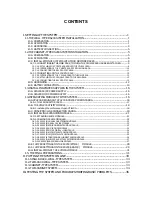
DS200 Installation Guide
DS200 Installation Guide
DS200 Installation Guide
DS200 Installation Guide
V003. 25.06.2002
B-13
Although special tools are required for measuring the sufficiency of grounding of the electric
installation of the building precisely, voltages between Neuter-Phase and Neuter-Ground
can be measured for getting a rough idea.
The Neuter-Phase voltage should be 180-260 VAC and the Neuter-Ground voltage should be
1-2 VAC. Those values must be consistent. Possible voltage leakage in grounding installation
may damage your exchange, just like all other devices that require grounding.
Water installation of the building can be used for grounding, provided that the pipes are of
metal and no insulation material has been used at junctions. Indeed, the most secure
grounding method is inserting a copper rod that is 1.5 cm in diameter with 1.5 m of length, or
inserting a copper plate with 1 m
2
of area to the ground and connecting it to the exchange
through a copper grounding cable. The cable should be fastened tightly to the rod or to the
plate and precautions should be taken against corrosion.
The cable coming from the grounding plate or grounding system must be connected to the
ground connection point of the exchange.
The DS200 Exchange and auxiliary racks are connected to each other tightly at the ground
connection points with the ground connection cable that comes with the shipped hardware.
A- DS200 Main Rack
B- DS200 Auxiliary rack
C- The grounding cable
D- The copper grounding plate or rod
Figure – 8
!
ADDITIONAL GROUNDING MUST BE PROVIDED, IF SOUNDNESS OF
THE GROUNDING OF THE ELECTRIC SYSTEM CANNOT BE GUARANTEED.
For providing the internal inter-rack grounding, first connect the grounding cable and the
grounding screw of the first rack, which is under the rack. Then, connect the grounding
screw that is under the first rack and the grounding screw of the second rack. Repeat the
same operation for the third rack. Afterwards, connect the cabinet grounding screw and the
external grounding system that has been installed for the cabinet, in order to provide
grounding for the entire cabinet.
For the two-cabinet structure, the grounding points of both cabinets must be the same.































